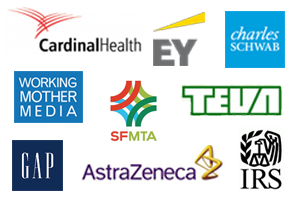What Is Gender Partnership?
Diagnostics
How far does your company have to go to achieve the benefits of Gender Partnership? Our Diagnostic team will do high level reviews of employee surveys and initiatives, conduct one-on-one interviews with leaders and high potentials, and assess your current state.
Based on their findings, they’ll recommend a specific series of both simple and complex actions that will enable your organization to include, integrate and rely on great women leaders working side by side with great men leaders.
What Participants Say…
“In a constructive and optimistic way, you helped us unlock the market and talent potential that gender partnership brings — and reap considerable economic benefits.”
“I am leaving this program with a clear sense of why hiring women drives innovation and new thinking among men.”
“Every time we have a group, we get more men on board. It starts with a few, then it’s eight, then 16. The men in the class are bringing with them the people they work for and who work for them.”
“I have a whole new awareness of my unconscious bias and how decisions I’ve made have been the result.”
A Sampling of Our Clients
- Cardinal Health
- AstraZeneca
- Ernst and Young
- Charles Schwab
- Teva Pharmaceuticals
- Astellas Pharmaceuticals
- Internal Revenue Service
- Gap
- San Francisco Municipal Transit Authority
- Hewlett-Packard
- US Global
- Working Mother Media
- World Pulse
“For me, this was one of those rare worthwhile programs which offered
just-in-time learning and provided support for ongoing practice
in fostering the full contribution of my female colleagues.”
—Fortune 20 Executive on the Partners Leading Change program, 2015
We Deliver Results
NEW! Leadership Strategies for Effective Allyship
Rayona shares how being an ally can have a lasting impact, especially when allies implement the 3 P’s: Push, Promote and Protect. “In today’s world, allies need to really pour on the attention and have a weekly conversation, be diligent and authentic.” (18 min.)
Gender Partnership Produces Surprising Amounts of Happiness All Around
IGP’s scholar-cum-best-selling-author, Dr. Michael Kimmel, delivered a TED talk in June 2015 in which he pointed out the five ways that gender equity will make men (and women) happier, healthier, and more sexually satisfied. As well as being better fathers. And he did it with his usual panache and humor! 15 minutes.
Try Out Michael’s Mind-Openers
- “Privilege is invisible to those who have it.”
- “Without confronting men’s sense of entitlement, I don’t think we’ll ever understand why so many men resist gender equality.”
- “Gender equality is good for countries. It turns out, according to most studies, that those countries that are the most gender equal are also the countries that score highest on the happiness scale.”
- “The more gender-equal companies are, the better it is for workers, the happier their labor force is. They have lower job turnover and an easier time recruiting.”
- “Younger men today expect to be able to balance work and family with their partners. They want to be involved fathers.”
- “When men share housework and childcare, their children do better in school. Their children have lower rates of absenteeism, higher rates of achievement.”
- “When men share housework and childcare, they have more sex.”
- “We know now that gender equality is in the interest of countries, of companies, and of men and their children and their partners, that gender equality is not a zero-sum game. It’s not a win-lose. It is a win-win for everyone.”





